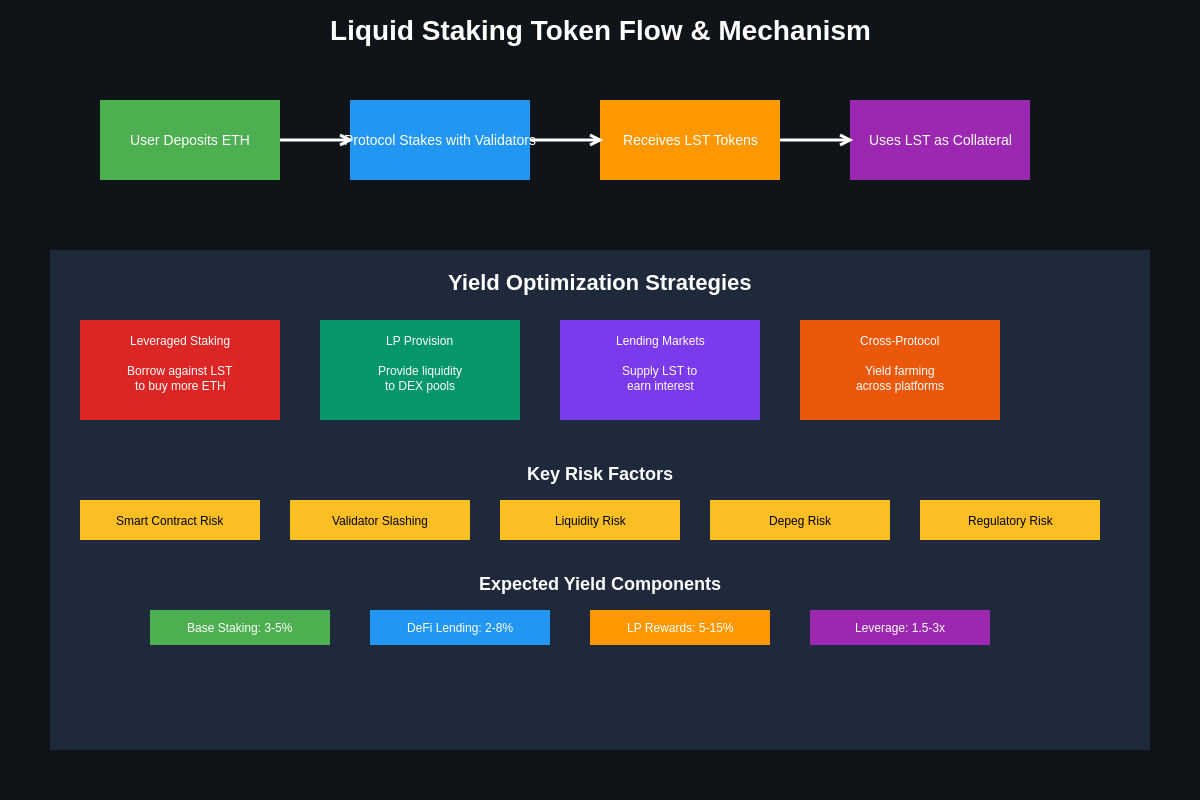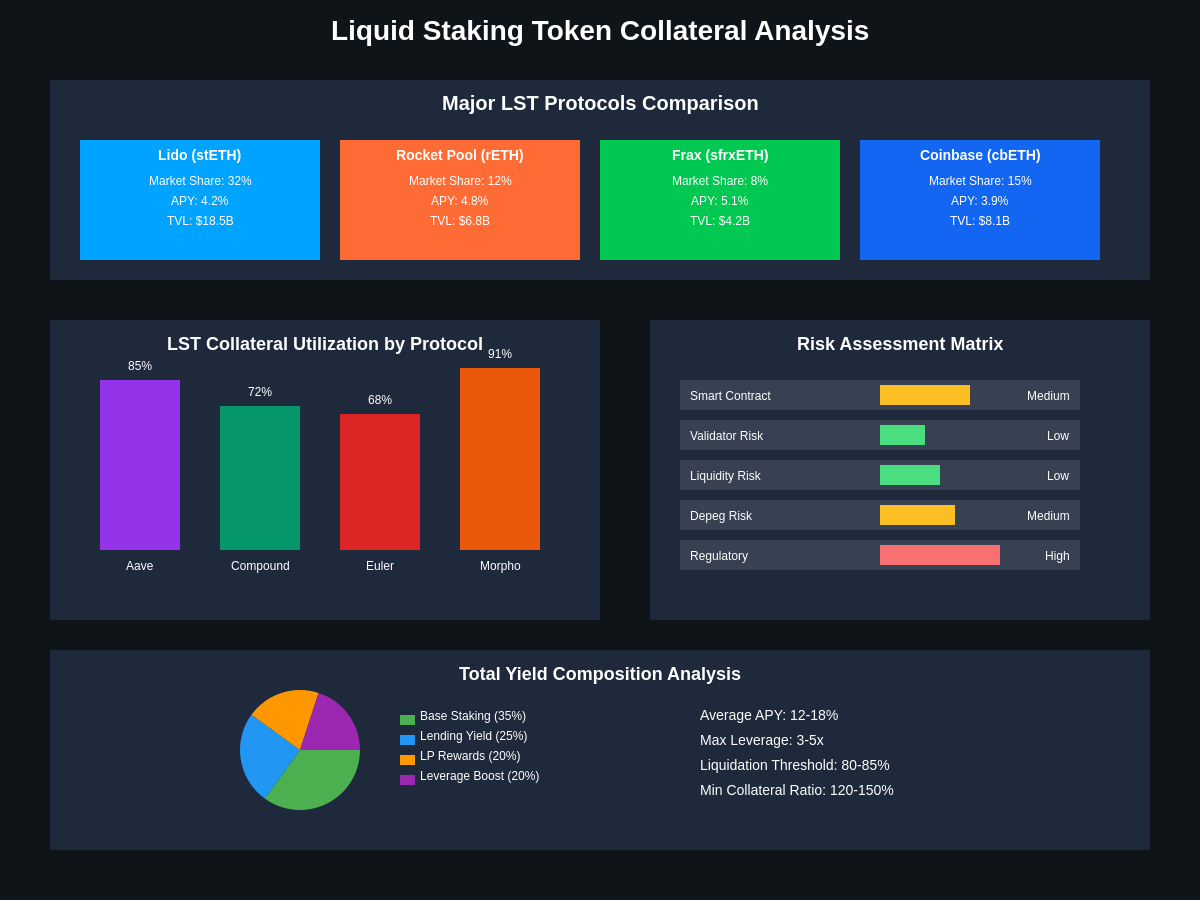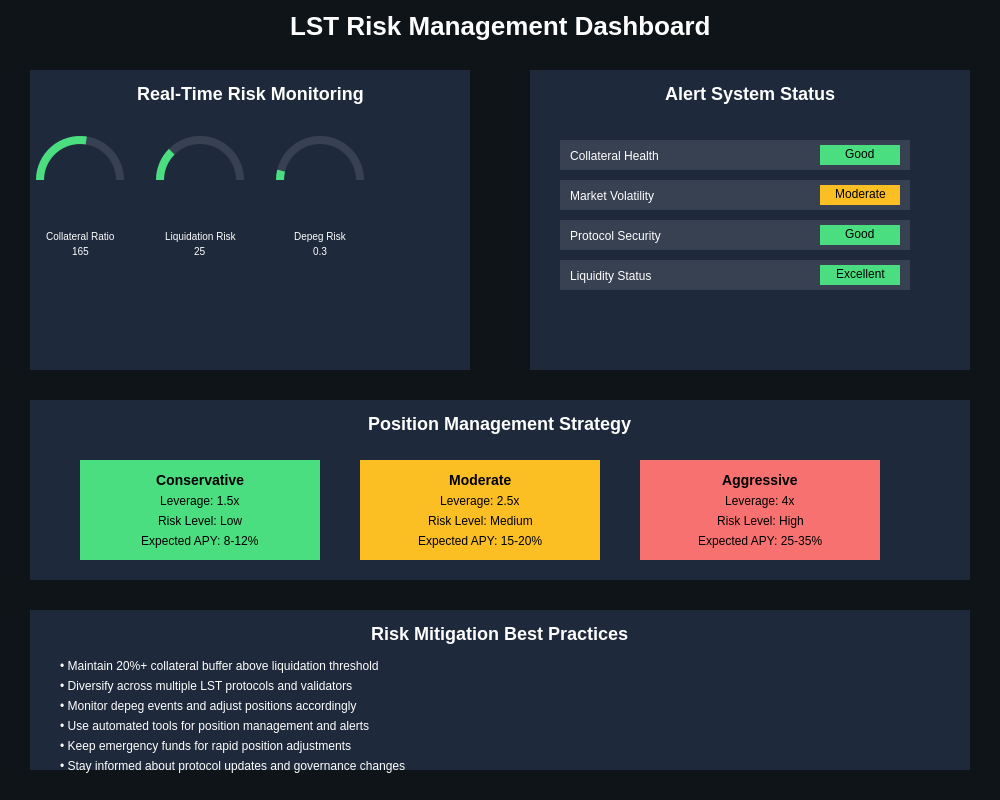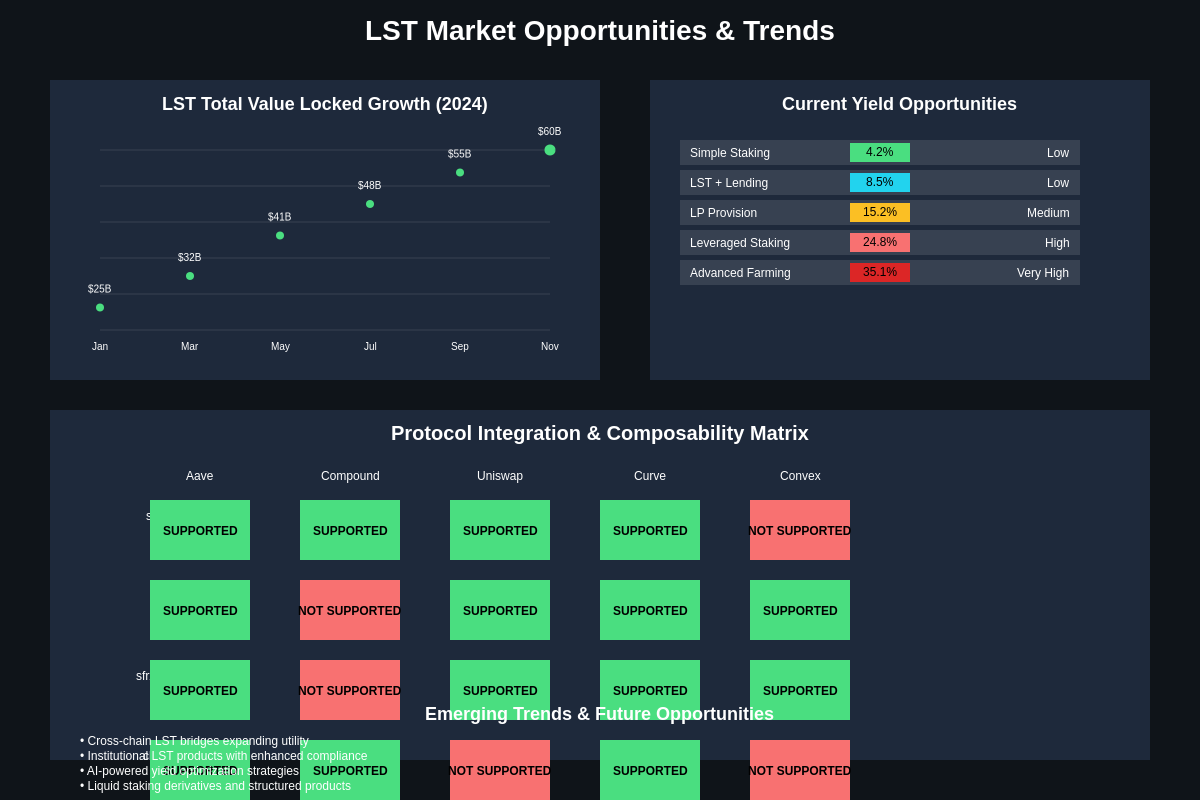The Evolution of Liquid Staking in DeFi
Liquid staking has emerged as one of the most transformative innovations in decentralized finance, enabling users to earn staking rewards while maintaining liquidity through tokenized representations of their staked assets. As we advance into 2025, liquid staking tokens (LSTs) have evolved beyond simple yield-bearing assets to become sophisticated collateral instruments that unlock multiple layers of DeFi composability and yield optimization strategies.
The fundamental value proposition of liquid staking tokens lies in their ability to solve the traditional trade-off between earning staking rewards and maintaining asset liquidity. When users stake their ETH on TradingView or other proof-of-stake assets, they typically lock their funds for extended periods, earning staking rewards but losing the ability to use those assets in other protocols. Liquid staking protocols address this limitation by issuing derivative tokens that represent the underlying staked position while allowing users to participate in additional DeFi activities.
The liquid staking ecosystem has experienced explosive growth, with total value locked across all liquid staking protocols exceeding $60 billion in 2024, representing approximately 35% of all staked ETH. This growth has been driven by institutional adoption, improved protocol security, and the increasing sophistication of yield optimization strategies that incorporate liquid staking tokens as fundamental building blocks.

Major liquid staking protocols including Lido, Rocket Pool, Frax, and Coinbase’s cbETH have established themselves as critical infrastructure providers, each offering unique approaches to validator selection, governance, and risk management. The diversity of liquid staking solutions has created a competitive landscape that benefits users through improved yields, enhanced security features, and innovative collateral mechanisms.
Understanding Liquid Staking Token Mechanics
Liquid staking tokens operate through sophisticated smart contract systems that automate the process of staking, validator management, and reward distribution while issuing transferable tokens that represent proportional ownership of the underlying staked assets. These mechanisms vary significantly across different protocols, each implementing unique approaches to address challenges related to validator selection, slashing risk, and liquidity provision.
The core mechanism behind most liquid staking protocols involves users depositing their proof-of-stake assets into smart contracts that aggregate these funds and delegate them to a network of validators. In return, users receive liquid staking tokens at a predetermined exchange rate that typically starts at 1:1 but evolves over time as staking rewards accrue to the protocol. The value of liquid staking tokens relative to the underlying asset increases as staking rewards are earned and reinvested, creating an appreciating asset that can be used across DeFi protocols.
Validator selection and management represent critical components of liquid staking protocols, with different approaches ranging from permissionless systems that allow any qualified validator to participate to curated sets of validators chosen through governance processes or technical criteria. The quality of validator selection directly impacts the overall yield and security of the liquid staking protocol, as poor-performing or malicious validators can result in slashing events that reduce the value of liquid staking tokens.
Reward distribution mechanisms in liquid staking protocols typically involve automatically compounding staking rewards into the token’s exchange rate, meaning that holders of liquid staking tokens benefit from compound growth without needing to actively claim and restake rewards. This automated compounding creates a significant efficiency advantage over direct staking, particularly for smaller holders who might face prohibitive gas costs when managing individual staking positions.
The underlying smart contract architecture of liquid staking protocols incorporates multiple security mechanisms including time delays for withdrawals, multi-signature controls for critical operations, and sophisticated slashing protection measures designed to minimize the impact of validator penalties. These security features are essential for maintaining user confidence and ensuring the long-term viability of liquid staking tokens as collateral assets.

Risk Assessment and Management Strategies
The utilization of liquid staking tokens as collateral introduces multiple layers of risk that must be carefully evaluated and managed through sophisticated risk management frameworks. These risks encompass smart contract vulnerabilities, validator performance issues, liquidity risks, and broader market dynamics that can affect the value and utility of liquid staking tokens in DeFi protocols.
Smart contract risk represents perhaps the most significant concern when using liquid staking tokens as collateral, as these protocols typically involve complex interactions between multiple smart contracts that manage staking, reward distribution, and token issuance. Bugs or vulnerabilities in any component of this system could potentially result in loss of funds or disruption of the liquid staking mechanism. The most robust liquid staking protocols have undergone extensive auditing by multiple security firms and have implemented formal verification processes to minimize smart contract risks.
Validator risk encompasses the potential for validators selected by liquid staking protocols to underperform or face slashing penalties, which can directly impact the value of liquid staking tokens. While diversification across multiple validators helps mitigate this risk, large slashing events or systemic validator issues could still affect token holders. Leading liquid staking protocols implement sophisticated validator monitoring systems and maintain insurance funds to protect against slashing events.
Liquidity risk becomes particularly relevant when liquid staking tokens are used as collateral in lending protocols or other DeFi applications. While these tokens are designed to maintain liquidity, market stress or protocol-specific issues could result in reduced liquidity or significant price deviations from the underlying asset. Users must consider the depth of secondary markets and the availability of exit liquidity when sizing their positions and determining appropriate collateralization ratios.
Regulatory risk represents an emerging concern as governments worldwide develop frameworks for staking and DeFi activities. Changes in regulatory treatment of liquid staking tokens or restrictions on their use as collateral could significantly impact their utility and market value. The evolving regulatory landscape requires ongoing monitoring and adaptation of risk management strategies.
Correlation risk arises from the fact that liquid staking tokens are inherently correlated with their underlying assets, meaning that market downturns affecting the base asset will also impact the liquid staking tokens. This correlation can be particularly problematic in leveraged strategies where users borrow against liquid staking tokens to acquire additional exposure to the same underlying asset.

Yield Optimization Strategies with LST Collateral
The use of liquid staking tokens as collateral enables sophisticated yield optimization strategies that can significantly enhance returns compared to simple staking or lending approaches. These strategies typically involve multiple protocol interactions and require careful management of leverage, risk exposure, and market timing to achieve optimal results.
Leveraged staking represents one of the most popular yield optimization strategies, where users deposit liquid staking tokens as collateral to borrow the underlying asset, which is then converted to additional liquid staking tokens, creating a leveraged position that amplifies both staking yields and price exposure. This strategy can be highly effective during bull markets but requires careful management of liquidation risks and funding costs.
Loop strategies involve repeatedly depositing borrowed funds to acquire additional liquid staking tokens, creating multiple layers of leverage that can significantly amplify yields. While these strategies can produce impressive returns during favorable market conditions, they also amplify risk and require sophisticated monitoring systems to prevent liquidation events. Advanced practitioners often use automated protocols that can adjust leverage ratios based on market conditions and predefined risk parameters.
Cross-protocol yield farming involves using liquid staking tokens as collateral across multiple DeFi protocols simultaneously to capture additional yield opportunities. This might involve providing liquidity to automated market makers, participating in governance token farming programs, or accessing specialized lending markets that offer enhanced rates for liquid staking token collateral. The complexity of managing positions across multiple protocols requires careful attention to gas costs, protocol risks, and timing considerations.
Arbitrage opportunities frequently arise between different liquid staking tokens and their underlying assets, creating potential yield enhancement through sophisticated trading strategies. These opportunities might involve exploiting temporary price discrepancies, participating in protocol incentive programs, or capitalizing on differences in yield rates across competing platforms. Successful arbitrage strategies require significant technical expertise and capital to execute effectively.
Delta-neutral strategies allow users to earn staking yields while hedging price exposure through derivatives markets, creating positions that benefit from staking rewards while minimizing directional price risk. These strategies are particularly attractive for institutional investors or risk-averse users who want to capture staking yields without taking significant price exposure to the underlying assets.
Protocol Integration and Composability
The true power of liquid staking tokens as collateral emerges through their seamless integration with various DeFi protocols, creating composability opportunities that enable users to simultaneously participate in multiple yield-generating activities. This composability represents a fundamental advantage of the DeFi ecosystem, allowing liquid staking tokens to serve as building blocks for increasingly sophisticated financial strategies.
Leading lending protocols including Aave, Compound, and Euler have integrated support for major liquid staking tokens, allowing users to deposit these assets as collateral while borrowing other tokens for additional investment opportunities. The integration of liquid staking tokens into these protocols has been carefully implemented with appropriate risk parameters, including conservative loan-to-value ratios and liquidation thresholds that account for the unique risk characteristics of these assets.
Automated market makers and decentralized exchanges have embraced liquid staking tokens as trading pairs and liquidity provision opportunities, creating additional yield streams for token holders who provide liquidity to these platforms. The combination of staking yields from the underlying tokens plus trading fees and liquidity mining rewards from DEX participation can create compelling total return profiles for sophisticated users.
Yield aggregation protocols have developed specialized strategies specifically designed to optimize returns from liquid staking tokens, automatically moving funds between different opportunities based on market conditions and yield differentials. These protocols provide access to complex strategies that would be difficult for individual users to implement and manage effectively, democratizing access to sophisticated yield optimization techniques.
Cross-chain protocols have begun supporting liquid staking tokens, enabling users to leverage their collateral across multiple blockchain networks and access yield opportunities that might not be available on their native chains. This cross-chain composability significantly expands the utility of liquid staking tokens and creates new opportunities for yield optimization and risk diversification.
The integration of liquid staking tokens with derivatives protocols enables advanced trading strategies including options selling, futures trading, and structured products that can provide additional yield streams or risk management capabilities. These integrations represent the cutting edge of DeFi composability and offer sophisticated users access to institutional-grade financial instruments.
Market Analysis and Performance Metrics
The liquid staking token market has demonstrated remarkable growth and resilience throughout 2024, with performance metrics indicating strong adoption across both retail and institutional segments. Analysis of staking yields on TradingView shows that liquid staking tokens have consistently outperformed traditional staking approaches when accounting for the additional utility and yield opportunities they provide.
Total value locked in liquid staking protocols has grown from approximately $25 billion at the beginning of 2024 to over $60 billion by year-end, representing a growth rate that significantly outpaced the broader DeFi market. This growth has been driven by increasing institutional adoption, improved protocol security, and growing awareness of the yield optimization opportunities available through liquid staking token strategies.
Yield performance analysis reveals that sophisticated liquid staking strategies have generated annualized returns ranging from 8% to 25% depending on market conditions, leverage ratios, and protocol selection. These returns significantly exceed traditional staking yields, which typically range from 3% to 6% for major proof-of-stake assets, demonstrating the value creation potential of liquid staking token strategies.
Market concentration analysis shows that while Lido remains the dominant liquid staking provider with approximately 45% market share, the ecosystem has become increasingly diverse with protocols like Rocket Pool, Frax, and newer entrants capturing significant portions of the market. This diversification has improved the overall resilience of the liquid staking ecosystem and provided users with more choices for protocol selection and risk management.
Liquidity analysis indicates that major liquid staking tokens maintain robust secondary markets with tight spreads and deep order books, supporting their utility as collateral assets. The development of specialized automated market makers and liquidity provision mechanisms has significantly improved the trading infrastructure supporting liquid staking tokens.
Risk-adjusted performance metrics demonstrate that liquid staking tokens have maintained relatively stable exchange rates with their underlying assets despite periods of market volatility, indicating effective risk management by protocol operators and resilient underlying mechanisms. However, periods of extreme market stress have occasionally resulted in temporary depegging events that highlight the importance of proper risk management when using these assets as collateral.

Institutional Adoption and Infrastructure Development
The institutional adoption of liquid staking tokens as collateral instruments has accelerated significantly throughout 2024, driven by improved regulatory clarity, enhanced infrastructure, and growing recognition of liquid staking as a legitimate asset class. Major institutional investors, including hedge funds, family offices, and corporate treasuries, have begun incorporating liquid staking strategies into their investment portfolios.
Custodial solutions for liquid staking tokens have evolved to meet institutional requirements, with major cryptocurrency custodians including Coinbase Custody, BitGo, and Fireblocks developing specialized services for institutional liquid staking token management. These solutions address key institutional concerns including segregated storage, compliance reporting, and integration with existing investment management systems.
Regulatory developments have provided increased clarity around the treatment of liquid staking tokens, with most jurisdictions treating them as digital assets subject to existing securities regulations rather than creating new regulatory categories. This clarity has facilitated institutional adoption by providing legal certainty around the use of liquid staking tokens in institutional investment strategies.
Infrastructure development has focused on improving the scalability, security, and user experience of liquid staking protocols, with major upgrades including enhanced validator management systems, improved slashing protection mechanisms, and more sophisticated risk management tools. These improvements have made liquid staking tokens more suitable for use as institutional-grade collateral assets.
The development of institutional-specific liquid staking products has created new opportunities for large-scale adoption, with protocols offering customized solutions including private validator sets, enhanced reporting capabilities, and specialized governance structures designed to meet institutional requirements. These products typically involve higher minimum investment thresholds but offer enhanced security and customization options.
Integration with traditional financial infrastructure has progressed through partnerships between liquid staking protocols and established financial institutions, creating bridges between DeFi yield strategies and traditional investment management systems. These partnerships have facilitated institutional access to liquid staking opportunities while maintaining compliance with existing regulatory frameworks.
Technical Implementation and Integration Patterns
The technical implementation of liquid staking tokens as collateral requires sophisticated smart contract architectures that can handle complex interactions between staking mechanisms, collateral management systems, and various DeFi protocols. These implementations must balance efficiency, security, and flexibility while maintaining compatibility with existing DeFi infrastructure.
Smart contract integration patterns for liquid staking tokens typically involve wrapper contracts that abstract the complexity of different liquid staking protocols while providing standardized interfaces for lending platforms and other DeFi applications. These wrapper contracts enable seamless integration while protecting underlying protocols from direct exposure to external contract risks.
Oracle integration represents a critical component of liquid staking token implementation, as accurate price feeds are essential for proper collateral valuation and liquidation mechanisms. Leading oracle providers including Chainlink, Band Protocol, and protocol-specific oracles have developed specialized price feeds for liquid staking tokens that account for their unique characteristics and risk factors.
Gas optimization techniques have become increasingly important as liquid staking strategies often involve multiple protocol interactions that can result in significant transaction costs. Advanced implementation patterns include batched transactions, meta-transactions, and layer-2 scaling solutions that can significantly reduce the cost of executing complex liquid staking strategies.
Multi-chain implementation patterns have emerged to support liquid staking tokens across different blockchain networks, enabling users to leverage their collateral across multiple ecosystems while maintaining exposure to their preferred staking assets. These patterns typically involve bridge mechanisms and cross-chain communication protocols that enable seamless asset movement.
Risk management implementation includes automated monitoring systems that can track collateral ratios, market conditions, and protocol health metrics to provide early warning systems for users and protocols. These systems often incorporate machine learning algorithms and predictive analytics to identify potential risks before they materialize.
Emerging Trends and Future Developments
The liquid staking landscape continues to evolve rapidly, with several emerging trends likely to shape the future development of liquid staking tokens as collateral instruments. Understanding these trends is essential for users and protocols seeking to position themselves advantageously in the evolving DeFi ecosystem.
Liquid staking derivatives represent an emerging category of instruments that build upon basic liquid staking tokens to create more sophisticated financial products. These derivatives might include options on liquid staking tokens, structured products that combine multiple liquid staking strategies, or synthetic instruments that provide exposure to staking yields without direct token ownership.
Cross-chain liquid staking solutions are developing to enable users to stake assets on one blockchain while receiving liquid staking tokens that can be used across multiple networks. These solutions address the fragmentation of the current liquid staking ecosystem and could significantly expand the utility and composability of liquid staking tokens.
Institutional liquid staking products are evolving to meet the specific needs of large investors, including enhanced reporting capabilities, specialized governance structures, and integration with traditional financial systems. These products are likely to drive significant capital inflows into the liquid staking ecosystem as institutional adoption continues to grow.
Regulatory frameworks for liquid staking are continuing to develop, with potential implications for how these tokens can be used as collateral and what compliance requirements may apply. The evolution of these frameworks will significantly impact the development of the liquid staking ecosystem and the strategies available to users.
Technological improvements including more efficient consensus mechanisms, enhanced slashing protection, and improved validator infrastructure are likely to reduce the risks associated with liquid staking while improving yields and user experience. These improvements could make liquid staking tokens more attractive as collateral assets and enable new use cases.
Risk Mitigation and Best Practices
Successful utilization of liquid staking tokens as collateral requires comprehensive risk mitigation strategies that address the multiple layers of risk inherent in these complex instruments. Implementing robust risk management practices is essential for both individual users and institutional investors seeking to maximize returns while protecting their capital.
Diversification strategies should encompass multiple dimensions including protocol diversification across different liquid staking providers, validator diversification within individual protocols, and asset diversification across different underlying staked assets. This multi-layered approach helps protect against protocol-specific risks, validator performance issues, and asset-specific market movements.
Position sizing and leverage management require careful consideration of individual risk tolerance, market conditions, and the specific characteristics of different liquid staking tokens. Conservative approaches typically involve maintaining moderate leverage ratios and ensuring adequate collateral buffers to withstand market volatility and potential liquidation events.
Monitoring and alert systems should be implemented to track key metrics including collateral ratios, liquidation prices, protocol health indicators, and market conditions that could affect liquid staking token positions. Automated monitoring systems can provide early warning of potential issues and enable timely position adjustments.
Exit strategy planning involves maintaining sufficient liquidity reserves and understanding the mechanics of unwinding complex liquid staking positions under different market conditions. This planning should include consideration of withdrawal timeframes, potential slippage costs, and alternative exit mechanisms that might be available during market stress.
Protocol due diligence should encompass comprehensive evaluation of smart contract security, audit history, governance mechanisms, validator selection processes, and track record of the protocol development team. This due diligence should be updated regularly as protocols evolve and new information becomes available.
Insurance and hedging strategies can provide additional protection against specific risks including smart contract failures, slashing events, and market volatility. While insurance options for liquid staking tokens remain limited, the market is developing and users should evaluate available protection mechanisms as part of their overall risk management approach.
Regulatory Considerations and Compliance
The regulatory landscape surrounding liquid staking tokens as collateral continues to evolve, with different jurisdictions taking varying approaches to the classification and treatment of these instruments. Understanding the regulatory implications is crucial for both individual users and institutions considering liquid staking strategies.
Securities regulation represents a primary area of regulatory focus, with authorities in various jurisdictions evaluating whether liquid staking tokens should be classified as securities, commodities, or other types of financial instruments. The classification can significantly impact how these tokens can be marketed, sold, and used as collateral in different jurisdictions.
Tax implications of liquid staking strategies can be complex, involving considerations of staking rewards, token appreciation, borrowing activities, and the treatment of various DeFi transactions. Users should consult with qualified tax professionals to understand the specific implications of their liquid staking strategies and ensure proper compliance with applicable tax laws.
Anti-money laundering and know-your-customer requirements may apply to certain liquid staking activities, particularly when using centralized platforms or when interacting with traditional financial institutions. Understanding these requirements is essential for ensuring compliance and avoiding potential legal issues.
Custody and fiduciary requirements for institutional users may impose specific obligations regarding the safekeeping and management of liquid staking tokens. These requirements can affect protocol selection, custody arrangements, and operational procedures for institutional liquid staking strategies.
Reporting and disclosure requirements may apply to certain types of liquid staking activities, particularly for institutional investors or in jurisdictions with comprehensive cryptocurrency reporting requirements. Maintaining proper records and understanding reporting obligations is essential for regulatory compliance.
The evolving nature of cryptocurrency regulation means that users must stay informed about regulatory developments and be prepared to adapt their strategies as new requirements emerge. Engaging with qualified legal and compliance professionals is recommended for users with significant liquid staking exposures or complex regulatory requirements.
Conclusion and Strategic Outlook
Liquid staking tokens have established themselves as fundamental building blocks of the modern DeFi ecosystem, offering users unprecedented opportunities to optimize yields while maintaining liquidity and composability. The evolution of these instruments from simple staking derivatives to sophisticated collateral assets represents a significant advancement in decentralized finance capabilities.
The strategic outlook for liquid staking tokens as collateral remains highly positive, driven by continued innovation in protocol design, growing institutional adoption, and the expanding ecosystem of DeFi applications that support these instruments. The combination of base staking yields with additional DeFi opportunities creates compelling value propositions that are likely to drive continued growth in adoption and utilization.
However, success in liquid staking strategies requires sophisticated understanding of the risks involved, careful implementation of risk management practices, and ongoing monitoring of the rapidly evolving ecosystem. Users must balance the pursuit of enhanced yields with prudent risk management to achieve sustainable long-term results.
The integration of liquid staking tokens with emerging technologies including layer-2 scaling solutions, cross-chain protocols, and advanced derivatives markets is likely to create new opportunities for yield optimization and risk management. Staying informed about these developments and adapting strategies accordingly will be essential for maintaining competitive advantage in the evolving landscape.
As the liquid staking ecosystem continues to mature, we can expect to see continued improvements in security, efficiency, and user experience that will make these instruments increasingly attractive as collateral assets. The development of more sophisticated risk management tools, enhanced regulatory clarity, and improved institutional infrastructure will likely accelerate adoption and expand the addressable market for liquid staking strategies.
The future of liquid staking tokens as collateral instruments appears bright, with significant opportunities for users who can navigate the complexities of this evolving ecosystem while maintaining appropriate risk management practices. The combination of technological innovation, growing adoption, and expanding utility suggests that liquid staking tokens will continue to play an increasingly important role in the future of decentralized finance.
Disclaimer: This article is for informational purposes only and does not constitute financial advice. Cryptocurrency investments involve substantial risk, including the potential loss of principal. Liquid staking tokens carry additional risks including smart contract vulnerabilities, validator performance issues, and potential depegging events. Past performance does not guarantee future results. Users should conduct their own research and consult with qualified financial advisors before making investment decisions. The regulatory status of liquid staking tokens varies by jurisdiction and may change over time. Always ensure compliance with applicable laws and regulations in your jurisdiction.